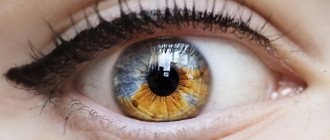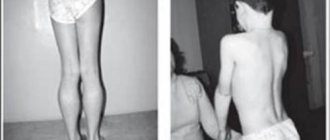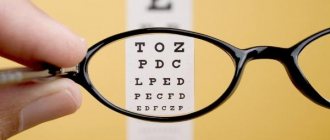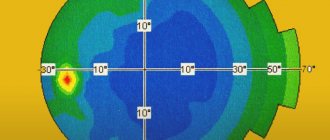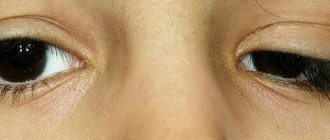Types of myopia
The form of this refractive pathology depends on the existing classification. Depending on the type and location of the affected structure, the following types of myopia are distinguished:
In this article
- Types of myopia
- True myopia
- False myopia
- The main causes of congenital myopia
- Acquired myopia
- Symptoms of acquired myopia
- Preventive measures for myopia
- Axial (axial) - elongation of the eyeball along the anteroposterior axis, not accompanied by a violation of the refractive system.
- Lenticular - increasing the refractive power of the lens. This condition is often a complication of diabetes mellitus and a consequence of taking potent medications.
- Damage to the corneal layer is excessive curvature of the cornea in combination with pronounced refractive power.
According to the mechanism of development of the disease, false and true myopia are distinguished. Each of these conditions has certain characteristics.
How to help
“If a child is nevertheless diagnosed with myopia, then treatment should begin as early as possible. It is impossible to cure the disease completely, in the sense that it is impossible to reduce myopia. But it is quite possible to slow down or stop its growth,” says Igor Aznauryan.
Today there are many options for vision correction for myopia.
First, regular, simple glasses. If vision is reduced by 0.5 or lower (the child does not see below the fifth line on the table of signs), he needs glasses.
Secondly, in some cases, ophthalmologists prescribe bifocal glasses - they provide correction for both distance and near. These glasses do not need to be removed, they are very convenient, since the child can look through the upper part of the lenses at the board, and through the lower part at the textbook.
Thirdly, orthokeratological correction or “night lenses” is also used. To achieve the effect, you need to stay in them for at least 8 hours.
The peculiarity of the method is that even after removing the lenses, visual acuity remains for some time, which allows the child to see perfectly during the day without glasses. But we must take into account: the effect of orthokeratological lenses is completely reversible - gradually during the day the cornea returns to its original shape, so it is necessary to wear lenses every night.
Fourthly, laser vision correction is used. If your child’s myopia does not progress within 3 years, it is possible to undergo laser correction. There is no need to wait for the notorious 18 years if myopia is already stable and the growth of the eyeball is not observed - this is an outdated opinion of ophthalmologists, which prevents many parents from giving their children one hundred percent vision, emphasizes Dr. Aznauryan.
True myopia
Such a pathological deviation entails organic damage to the main elements of the eyeball - the lens and cornea. There are acquired and congenital true myopia. If the cause of myopia is not eliminated in time, complications may arise. Over some time, existing visual impairments will be compensated by the work of the accommodative apparatus. However, as it progresses, the compensatory capabilities of the ocular system decrease to a minimum level.
Why is early diagnosis important?
The main task of doctors is to quickly detect congenital myopia. If this pathology is not detected in the first months of life, it can lead to even more serious disorders of the visual function of the eye. The child undergoes the first examination by an ophthalmologist in the maternity hospital, however, it is not always possible to determine this pathology in a newly born child. In modern and well-equipped clinics, visual impairment can be detected as early as three months of age.
Late diagnosis of congenital myopia and lack of correction in the form of glasses or contact lenses can lead to such serious disorders as early as the beginning of the second year of life, such as:
- strabismus;
- refractive amblyopia, which is characterized by a sharp drop in visual acuity that cannot be treated.
False myopia
False myopia is characterized by a pronounced spasm of accommodation, that is, a dysfunction of the eyes to adapt to a changing situation. It often develops in children and adolescents with excessive strain on the accommodation apparatus. The mechanism of this type of myopia is based on a spasm of the ciliary muscle, which appears during prolonged viewing of closely located objects. When you remain in a state of tension for a long time, nervous regulation and metabolism in muscle fibers are disrupted. Therefore, when trying to look into the distance, the refractive power of the eye lens will not decrease and the object in question will be blurred.
Most often, the causes of false myopia and accommodative spasm are prolonged, many hours of visual overload. Provoking factors are:
- lack of night sleep, non-compliance with the rest regime;
- long continuous work on a PC, watching TV;
- performing fine motor activities in poor lighting;
- lack of vitamins, unbalanced nutrition, poor diet.
False myopia is not associated with refractive problems or anatomical defects of the eyeball. Visual perception is almost completely restored after the root cause of the spasm is eliminated. But we should not forget that repeated episodes of provoking factors and frequently repeated spasms of accommodation lead to the development of true myopia.
Recommendations for the prevention of myopia in children and adolescents with a genetic predisposition
Prevention of myopia in children should be carried out from a very early age.
Removing bad habits
Since no method of treating myopia provides a 100% guarantee of getting rid of the disease, I would like to analyze in detail the methods of prevention aimed at preventing the development and progression of myopia.
Children with a family history of myopia should be seen by an ophthalmologist, examined by a doctor twice a year and strictly follow all recommendations.
- Compliance with the rules when reading (it is not recommended to read while lying down, in transport, lighting should be sufficient).
- Compliance with the rules when watching TV (time limit, viewing before bedtime is not recommended, it is forbidden to be at a close distance from the screen).
- Compliance with the rules when working on a computer (time limits, breaks in work, the monitor should be located at a distance of about 40 cm).
- Limiting children's use of modern gadgets: phones and tablets.
- Active leisure time, frequent walks.
- Daily exercises for the eyes.
- Compliance with dietary recommendations including the inclusion of meat and fish dishes, broths, eggs, herbs, vegetables and fruits in the diet.
Useful video
Myopia or myopia: unique information!
The main causes of congenital myopia
Due to the development of refractive pathology, a distinction is made between acquired and hereditary myopia.
The real causes of myopia lie in genetic predisposition, expressed in the characteristics of the functioning of the lens and the structural features of the retina. It is noteworthy that the transmission mechanism directly depends on the degree of myopia. For example, weak congenital myopia is characterized by an autosomal dominant type of inheritance. Thus, if a child inherits one defective gene, his risk of developing this disease increases several times. The likelihood of having visual impairment increases to 75-100% in children in families in which both parents suffer from myopia.
High degrees of myopia are characterized by an autosomal recessive mode of inheritance. This happens as follows: provided that one of the parents is healthy and does not act as a carrier of a defective gene, and the other suffers from congenital myopia, their child, most often, will not have vision problems. But he can inherit one “broken gene” and become an asymptomatic carrier of refractive pathology. If the father and mother both suffer from myopia, then the percentage chance of having a myopic baby will be 100. The root cause of congenital childhood myopia is usually caused by impaired development of the eyeball during intrauterine growth. This often occurs in the first trimester of pregnancy. But with congenital myopia, the key role is played by unfavorable heredity, since it is passed on to children from parents.
What is inherited?
Many eye diseases are inherited. If at least one of the parents suffers from myopia or farsightedness, the likelihood of their manifestation in the baby is 50 percent. The same can be said about strabismus, astigmatism (violation of the sphericity of the cornea and the correct shape of the lens).
“It is clear that if a child has a congenital pathology or a complicated heredity, you need to go for a consultation with an ophthalmologist as early as possible and, pardon the pun, do not take your eyes off him,” emphasizes Dr. Aznauryan.
Acquired myopia
We can talk about an acquired type of pathology when at the time of birth the baby does not show any signs of this disease, and the hereditary factor is completely excluded. In this case, the appearance and development of the disease is facilitated by any external environmental factors:
- vitamin deficiency, poor nutrition, primary weakening of accommodation;
- unfavorable working conditions;
- keratoconus – degeneration of the cornea;
- daily excessive visual stress.
The most common causes of myopia acquired during life include previous infectious, viral diseases, and injuries of various types. It can occur due to the presence of anatomical defects of the eyeball, the refractive ability of the eyes, and weakness of the sclera. The development of acquired myopia occurs gradually, often the disease progresses quite quickly. The rate of appearance and development of eye pathology is determined by the intensity of the influence of external factors and features of the internal structure of the organs of vision.
School is a time of risk
It is during school years that many children develop myopia - the scourge of modern schoolchildren. We talked about the reasons: visual stress at school and at home, abuse of gadgets, non-compliance with the visual regime.
Teenagers who are preoccupied with problems of their own attractiveness have additional negative factors: they begin to hide vision problems from their parents so as not to wear glasses. And if the moment is missed, treatment begins late, when the child is not minus 1-2, but already minus 3-4.
Symptoms of acquired myopia
The disease begins to manifest itself in childhood. However, the child is not always able to adequately assess the presenting symptoms and talk about them in a timely manner. Therefore, it is important for parents to carefully monitor the baby’s condition in order to take timely measures. The following complaints should alert you:
- pain, burning, feeling of “sand in the eyes”;
- frequent episodes of headaches;
- tearing of the eyes (for example, from exposure to bright light);
- greatly dilated pupils;
- increased size of the palpebral fissure.
When trying to focus on a distant object, myopic patients constantly squint. While reading, the letters are bent low, moved closer to the objects being examined, trying to better see the details.
If such symptoms are detected, you should immediately show the child to an ophthalmologist.
After a full diagnosis, the doctor can make a correct diagnosis, determine the severity of myopia, and tell you about the presence or absence of concomitant visual pathologies.
Symptoms
In the initial stages, children diagnosed with myopia are easier to treat, this fact is confirmed by statistical data.
A child, due to his age, cannot normally formulate complaints and explain to his parents that he has vision problems. He just doesn't understand the difference between seeing it as bad or good. Therefore, it is important to take your child to the doctor on time. It is necessary to sound the alarm in a timely manner if the baby quickly gets tired when reading, rubs his eyes, or complains of a headache. Older children can already formulate their complaints and express them to the doctor. Then the doctor will be able to make a timely diagnosis and prescribe treatment. Therefore, parents should not ignore the symptoms.
Preventive measures for myopia
It is important to understand that timely treatment of myopia will help to avoid many complications: amblyopia, strabismus, vitreous detachment, pathological changes in the retina (detachment, hemorrhage, etc.). Such disorders can cause complete loss of vision. The ophthalmologist will draw up a treatment regimen taking into account the physiological and age characteristics of the patient, and, if necessary, select suitable corrective optics. In addition, prevention is of no small importance when correcting congenital or acquired myopia. First of all, you need to pay attention to the equipment of the place where the child does homework, plays, reads or draws. It is strongly recommended to limit the time spent watching TV and computer. It is better to spend as much time as possible outside in the fresh air. During walks, the child should often look at greenery, tree crowns, and distant buildings.
Your diet should include beneficial microelements, vitamins A, C, and group B. It is also necessary to undergo a preventive examination by an ophthalmologist at least once a year. In a situation where you have to deal with a long-term infectious disease, it is best to consult an ophthalmologist immediately after recovery to check your eye health.
The essence of genetics
All information about a person is encrypted in genes. Each trait, including the risk of various diseases, is encoded by two genes: one passed on by the mother, the second by the father. The combination of two genes determines the characteristics of the trait.
Genes are located on chromosomes: 22 pairs of somatic chromosomes, and the 23rd pair determines the sex of a person (XX and XY). Genes can be dominant (major, designated A, B, C) or recessive (a, b, c).
Genetic information is transmitted autosomally (through somatic chromosomes) or linked to sex chromosomes (the trait will appear in a certain sex).
In an autosomal mode of inheritance, a dominant trait will appear in any combination of genes (AA, Aa), and a recessive trait will appear only in the form of a homozygote (aa).
Myopia genes
- dominant A – codes myopia of weak and moderate degree (up to -4);
- recessive b - encodes severe myopia (from -4 or more).
How is the disease transmitted to a child?
Thus, a child who has inherited the combination of genes AA, Aa, bb from his parents will be born with myopia. A child with the genetic code aa, Bb, BB will be healthy in this regard and have good vision. At the same time, a person with Bb genes is a carrier of the disease, and there is a risk of transmitting the disease to their children.
Due to various options for the transmission of genetic information, it may happen that, for example, parents with good eyesight may have both a healthy child and a baby with myopia. And parents who both suffer from this disease can get a child without vision problems.

